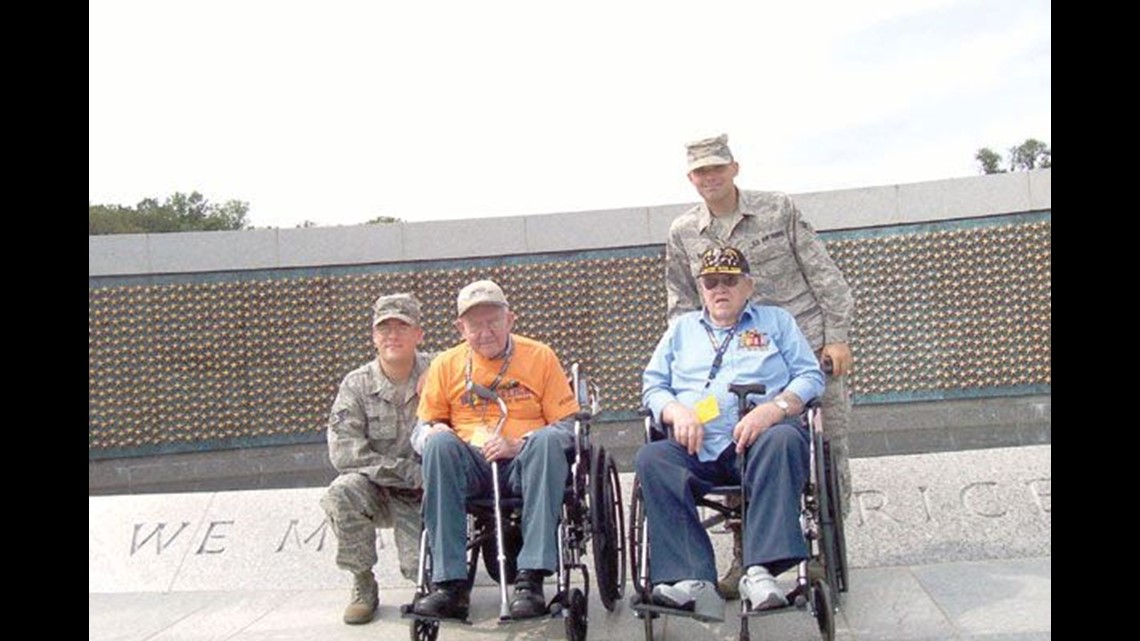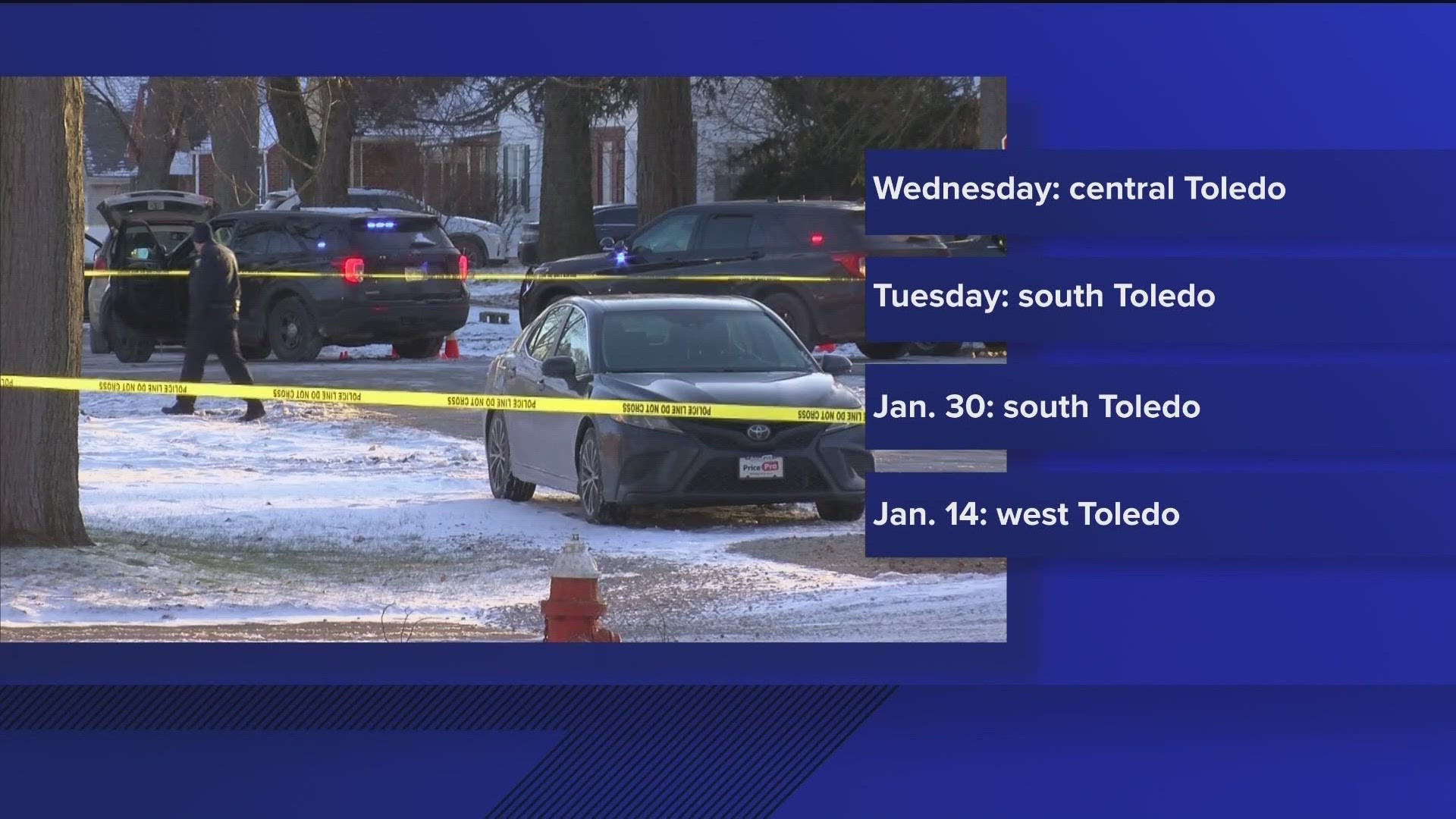

By John Montgomery
Focus Reporter
They and their brothers fought for their country, watched friends and fellow servicemen die and helped stamp out the tyranny of Germany and Japan.
Wednesday Fostorians Dale Bennett and Lloyd McKee and more than 50 other veterans again joined forces to fly from Toledo to Washington, D.C. to tour the World War II Memorial.
"That World War II Memorial is one of the most beautiful things I think I've every seen. It's really worth the trip," said Bennett, who'd never been to Washington, D.C. before Wednesday. "I just can hardly explain how it makes me feel to be able to go and see something like that."
The trip was handled through the northwest Ohio chapter of Honor Flight, a non-profit, volunteer organization that flies veterans to Washington, D.C. to see the memorials dedicated in their honor.
All of the expenses for the veterans - approximately $400 per person - are paid through donations. The Fostoria VFW, whose commander is Dennis Smith, Bennett's nephew, raised the money to pay for the trip for Bennett and McKee.
Each veteran is assigned a companion, called a Guardian, who assists with special needs, such as oxygen tanks, wheelchairs or other items. Guardians pay for their own transportation.
Honor Flight currently focuses on World War II veterans, but each includes stops at a variety of places - Korean Memorial, Vietnam Memorial, Marine Corps Memorial, Arlington National Cemetery and Tomb of the Unknown Soldier.
Of course, the World War II Memorial is a point of emphasis.
The oval-shaped grounds include two 43-foot-tall arches, each representing the two theaters of war (Pacific and Europe), with an oval reflecting pool in the middle.
Inside are 56 pillars - one for each state, territory and the District of Columbia at the time of the war. The pillars are evenly arranged in two semicircles, one at each end of the reflecting pool.
Each pillar has two bronze wreaths and small fountains are at the base of each arch.
There is also a Freedom Wall of 4,048 gold stars. Each gold star represents 100 American service personnel who died or remain missing in the war, according to the National Parks Service.
The 405,399 American dead and missing from World War II are second only to the loss of more than 620,000 Americans during our Civil War, according to the National Parks Service.
Seeing the stars meant a lot, McKee said.
"It was pretty impressive; kind of emotional," he said. "I just wish more people had a chance to go see it, even if it wasn't on (an Honor Flight trip).
"It means quite a bit. There's a lot of people who deserve to go that can't go," said McKee.
Age and medical conditions are playing a role in that.
Bennett, an 85-year-old Navy veteran, and McKee, an 88-year-old Army veteran, were part of 55 veterans, seven of whom are aged 90 to 94, who took part in Wednesday's trip.
Currently, officials say 535 veterans in northwest Ohio and thousands more across the country are on the waiting list to take part.
Though he'd been to Washington, D.C. a handful of times before, Wednesday marked McKee's first trip to the World War II Memorial, a trip he said he hopes more veterans get to make before they pass on.
"The trip itself, it seemed liked everything was so planned, right down to the 'T.' It seemed like everybody had a (Guardian) from when we got there until we got on the plane at night," McKee said.
"It took a lot of planning to make it go. I'm glad that I had a chance to go, but I know of a lot of other veterans who would like to go, too, but who don't have a chance," he said.
McKee was one of four brothers who all served in Army during the war and returned home. His oldest brother, Clair, and his twin, Floyd, are now deceased. His younger brother, Reid, is still alive.
Donations can be sent to Honor Flight Northwest Ohio, P.O. Box 23018, Toledo, Ohio 43623. For more information, visit www.honorflightnwo.org.
McKee joined the Army in August 1942 and spent time at Camp Shanks in New York before taking a 20-day transport to England.
He then trained for six months in Ireland before being transferred to southern England to prepare for D-Day.
McKee and his unit landed on Normandy about two weeks after the invasion and began the march across Europe.
They arrived at Dachau concentration camp a day after it was liberated in the spring of 1945.
The camp opened in 1933 on the grounds of a former munitions plant. It was the first such camp set up by the Nazis and their future concentration camps were based on Dachau. The camp was later enlarged from 1937-38 through the use of prisoner labor.
More than 200,000 prisoners from more than 30 countries were housed at the camp during its use. It's thought more than 25,000 prisoners died in the camp, while another 10,000 died in Dachau's subcamps.
"One thing that sticks in my mind is that our outfit was pretty close to Dachau concentration camp," McKee said.
"It was quite a scene. You could see stacks of corpses piled in rooms as high as the ceiling," he said. "Of course, they weren't all dead. There were cages of them with their striped uniforms on, waiting their turn [to be killed]."
After the War, McKee had several odd jobs before working 26 years for the Nickle Plate Railroad, spending many of them alongside Bennett, and another 10 years for Marathon Oil.
McKee didn't move to Fostoria until he married his wife, Evelyn Higley.
The 1940 Vanlue High graduate had the first of his handful of trips to Washington, D.C. on a class trip. However Wednesday's trip was his first to the World War II Memorial.
Bennett served in the Navy as a fireman first class, joining up in December 1942. Two brothers (Donald and Ralph) and a brother-in-law (Paul Moser) later followed him into the service
Like many in his day, Bennett quit high school to join up, and later received his diploma through the Veterans Administration after the war.
And like many in his day, he fudged the birthday on his birth certificate. However, his change had a different twist.
"I was 18, and at that time you had to wait for the draft; you'd get in there and they'd tell you what service you were going to be in," he said. "I wanted to go in the Navy, so I backed my birthday up to where I was 17. You could enlist at 17 with your mother's permission.
"Everybody wanted to get their birth certificate advanced a year or two for different reasons," Bennett said, "but I went back with mine because I didn't want to be drafted into the Army or whatever. Where I would have ended up, I don't know."
Where he ended up was in the Atlantic and Pacific aboard three aircraft carriers.
His first ship was the Pybus, but the U.S. sold the ship to the British and Bennett had to travel back across the country to the West Coast for his next ship, the Wake Island.
The Wake Island travelled east through the Panama Canal and joined of a convoy that crossed the Atlantic to transport airplanes to Karachi, India.
Bennett caught pneumonia on the way back to America and was sent to the Norfolk Naval Yard in Portsmouth, Va., and Asheville, N.C., for treatment.
Once he recovered, he was transferred to a new carrier named the Shangri-La and sent back through the Panama Canal to the Pacific.
It was aboard the Shangri-La where Bennett experienced action, with battles involving Iwo Jima, the Philippines and Okinawa.
"I was a fireman and all my duties were belowdecks so I never saw a thing," he said, "but I was down there where all the noise was amplified quite a bit - the guns going off, shooting at them Kamikazes, and if you hit one, it'd explode right close to the ship.
"We had a big carrier, but you could still feel the effects of the explosion. So noisy," Bennett said.
Bennett was discharged in November 1945 and worked on the Nickle Plate Railroad on the repair track with McKee for years until McKee went to work for Marathon Oil.
He said it wasn't until after the war that he began to fully realize his place in history.
"When I first got out of the service, I didn't think much about what I'd done (in the war) ... And then after I got older, I got to thinking, 'Boy, a lot of this stuff was going on and I was there,' but I just didn't realize what was going on at the time," Bennett said.

